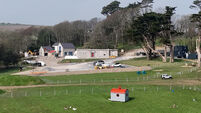GAA must sell its great games — but never its soul
One by one, big, brooding, broad-shouldered beasts came pawing and charging into the amphitheatre. And, one by one, they left on their flanks, legs tied, dragged by horses to the nearby abattoir.
I wouldn’t say I was overly enamoured by the spectacle but I thoroughly enjoyed the deep sense of tradition. A summer’s evening among 25,000 Spaniards. The cheap seats in the sun, the rich people sitting in the shade. Everyone talking, pausing only when the next bull entered the arena.
Sampling a slice of culture unique to Spain was an unforgettable experience.
Buying tickets for the night was a straightforward exercise. The guidebook revealed that event information and tickets were available at kiosks dotted across the city. It was easy. In contrast, consider the rigmarole that would confront the Spanish tourist in Ireland who has heard about our ancient game of hurling, the fastest field sport in the world, and a decent bloodsport too, if you catch the right game.
Our Spanish friend is in Dublin, and there is a Leinster Championship game at the weekend.
But how does he find out that the game is even on? More importantly again, how does he buy a ticket? Ring the county secretary? Fortunately, and at long last, it appears the GAA is finally going to make the task of buying tickets easier for everyone, natives and tourists alike.
At a press briefing in Croke Park on Monday, it was revealed that for this year’s Championship, tickets can be bought from more than 130 Centra and SuperValu outlets.
As the GAA becomes more professional and more commercial, it is gradually learning how to sell its old games in new ways.
Many of the changes are to be welcomed. But, in the rush to be modern and to maximise profits, it’s important the GAA strikes a balance.
A difference must be drawn between the marketing devices that are employed to sell tickets and the marketing devices used to sell games.
The culture of the games must be preserved. The pre-match parade around the pitch. Cheering before the end of the national anthem. Umpires in white coats. Supporters pouring onto the pitch after a game. (Sorry, I forgot).
Every time one of these rituals is changed or modified, a part of the game dies with it.
For instance, last year at a league match in Navan, I was pleasantly shocked when the Meath players lined out in their respective positions, where they stood for the national anthem. It made me pine for the days when this was standard practice.
Fourteen potential duels outlined for all to see and survey. Nowadays team-mates stand hugging each other; it’s just not the same.
The importance of retaining rituals was rammed home recently when reading Rafa Nadal’s autobiography.
BBC commentators aren’t being biased or jingoistic when they proclaim Wimbledon as the most prestigious, coveted, and cherished tennis tournament in the world.
The professionals thinks so too. Nadal has won them all — and Wimbledon is the title he places above all others.
His life story begins on Centre Court where he describes “the trimmed grass, the rich history, the ancient stadium, the players dressed in white, the venerable tradition — not a billboard advertisement in view”.
Nadal’s reverence for Wimbledon oozes from the pages. In contrast, this is how he depicts Arthur Ashe Stadium, the venue for the final of the US Open. “Elsewhere, breaks between games are times for quiet pause, but here the show never stops. Hard, pumping music blasts the eardrums, prizes are drawn. TV screens carry replays of the latest exchanges on court or, to even greater excitement, capture scenes from the crowd: couples kissing, cute kids smiling, celebrities posing, prize winners celebrating, and, every now and then, New Yorkers fighting.”
As the rest of the world slavishly apes the American way of promoting sport as entertainment, it’s crucial that there are institutions that have the confidence and conviction to retain their own identity.
There are no cheerleaders in Spanish bullrings. Popcorn and nachos are not for sale. And the GAA needs to tread carefully too. During last year’s All-Ireland Championship the half-time interval featured Hector Ó hEochagáin running around Croke Park interviewing fans. The noise, excitement, screaming from the tannoys — it was unbearable. The concept was flawed as, by finding out the thoughts of just two people, Hector denied everyone in the crowd the chance of discovering the thoughts of their neighbour. After 128 years, the GAA doesn’t need to copy every gimmick coming from the US>.
Greater inspiration can be drawn from the Plaza de Toros or the All-England Club. Real class, heritage and grandeur comes from doing things the way they have always been done.










